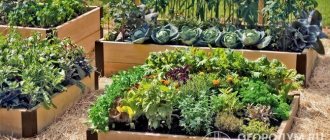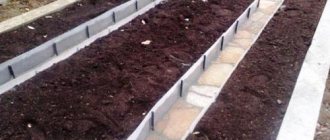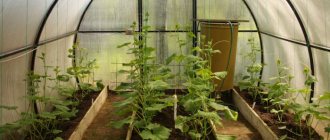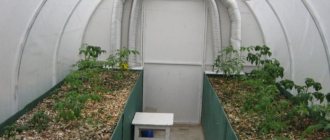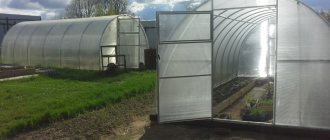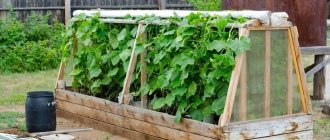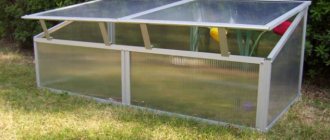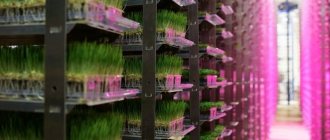The market offers a large number of materials that allow you to create raised beds with your own hands in the country. Various vegetable crops are grown annually using this method, obtaining abundant harvests. For example, the advantages of high pallet fences are convenience and order. Plastic beds also have certain advantages. At the same time, tall structures take up a lot of space, which is considered their disadvantage.
Beautiful tall vegetable gardens
What are raised beds suitable for?
Raised, warm beds are great for growing vegetables, herbs and annual flowers. The plants in them are located above ground level, the soil warms up well, which allows you to get an earlier harvest of fruits or cut flowers.
Raised beds in a greenhouse are very functional. They make it easier to care for plants, reduce labor costs, warm up faster in the spring, and protect from weeds. They can be filled with soil mixture suitable for a specific crop.
Raised beds are ideal for growing cucumbers. If there is no greenhouse, the structure can be installed in a sunny place, filled with plant debris and manure. By overheating, they will provide the seedlings with the warmth and nutrition they need. It is easy to cover such a ridge by turning it into a mini-greenhouse.
Potatoes are often grown in high beds. Gardeners who use a similar design enjoy a good harvest of clean and healthy tubers every year. Surprisingly, potatoes grow in layers in high beds. With regular watering, you can collect a bucket of tubers from the bush.
High beds are also suitable for growing raspberries. After all, unattended shrubs quickly spread throughout the area, and high sides will be a good barrier.
Brick sides
If stationary greenhouses made of polycarbonate or even glass are used, then it makes sense to build the walls of the beds from a more permanent material - bricks. Of course, you will have to work hard here, but the result is worth it. The step-by-step technology for constructing sides looks like this:
- along the perimeter of the flower bed they dig a narrow trench up to 30 cm deep;
- sand and crushed stone are poured onto the bottom (about 10 cm);
- concrete is poured to the top;
- after its final hardening, a half-brick wall is erected, up to 0.8 m high.
Next, soil is placed inside.
Their advantages and disadvantages
Bulk beds raised above the soil level, like any technology, have their advantages and disadvantages.
pros
- less weeds;
- you can use any soil mixture;
- protect from short-term frosts and wind;
- early ripening;
- good drainage and aeration;
- can be placed anywhere;
- more yield per unit area;
- Ideal for the elderly and people with back pain.
Minuses
- require abundant watering;
- significant material and physical costs for the construction of frames;
- on hot days the soil may overheat;
- in the fall, high beds freeze, so perennials and vegetables are not planted on them before winter;
- the risk of pest proliferation increases.
Before making raised beds, it is important to assess your material capabilities, study the site plan, dimensions and possible materials for future frames.
What shapes can they be
As design solutions at your dacha, you can install beautiful high beds of different shapes:
- Rectangular. The most common and convenient form of beds;
- Square. Small in area, they can become a spot decoration for small plots of land;
- Triangular. Having broken them into segments, it is convenient to use for growing a variety of greens;
- Polygonal. They can serve as the central point of the site, drawing attention to it;
- Round. Usually used for flower beds.
To save space and give the garden a special touch, it is permissible to use multi-tiered flower beds made of different materials.
Asbestos cement slabs
The material production technology allows us to obtain strong sheets that are resistant to aggressive environments. High beds reinforced with them will last for many years. However, there is a problem - asbestos is considered a very harmful material for humans. Fortunately, sheets are now made on a chrysotile base, which is much less dangerous. For additional protection, the workpieces are carefully painted with oil enamel in two layers.
Construct a box under the bed like this:
- dig a half-bayonet trench around the perimeter and drive in metal rods (about every meter);
- asbestos-cement parts, cut with a grinder to the required sizes, are installed behind them;
- soil is poured inside.
There is another, more complex option - the sheets are mounted in a frame of metal corners. They are connected by welding or bolts. Ordinary wavy slate is used in exactly the same way.
Types and methods of production
The quality of the beds, their appearance and durability depend on the materials used. If necessary, raised beds can be made from available materials without spending a lot of money.
Wooden
Board framing remains the most attractive option for gardeners. Instead, it is permissible to use logs, slabs, and vines.
Raised beds made of wood can be placed anywhere. The cost of such a structure is low, and the remains of the material can be found on any site.
The main disadvantages of wooden structures include a short service life, since wood quickly rots and collapses. Such structures are often favored by ants and other insects that harm plants. Therefore, any wood must be treated in advance with non-toxic protective agents.
To obtain beautiful interior beds, you can use ash or oak wood. Structures made of larch and cedar are considered the most durable.
The work on creating such beds consists of several stages:
- Level the selected area by removing a thin layer of turf.
- Take measurements using a tape measure and a square.
- Hammer support posts into the corners. They can serve as cuttings of bars.
- Use self-tapping screws to attach treated boards or other wooden material.
The box is ready. All that remains is to fill it with soil mixture and plant the plants.
Plastic
In the manufacture of discounts, plastic materials are increasingly used. They are durable, easy to install and maintain, and mobile. Insects and fungi rarely breed in them.
The main disadvantages of high beds made of plastic: toxicity of some materials, fragility, high price.
The easiest way to make beds with your own hands is from plastic panels, specially produced for finishing a garden plot. You can also use other available materials: dismantled window sills, PVC panels, siding remains.
Instructions for making a simple bed from plastic panels:
- Carry out the necessary measurements and calculations. Make a drawing.
- Cut panels to the required length and width.
- Prepare mounting angles.
- Connect the plastic sheets to the corners with self-tapping screws.
- Strengthen the structure with ties every 70–100 cm.
- Level the area.
- Place the box in the prepared place.
Useful video on how to make high warm beds from plastic panels in the country
From slate
Raised beds made of slate are easy to make with your own hands. Asbestos-cement sheets do not rot, withstand any weather disasters, and look neat.
How to make a bed from slate:
- Cut the slate sheets with a grinder across the waves.
- At the selected location, prepare trenches ½ deep from the expected height of the bed.
- Install the sides into the trench.
- Cover with soil and compact thoroughly. For a better effect, you can spill it with water.
- Secure the walls with pegs or iron rods. They should be driven in 50–100 cm from different sides of the sheet.
A vegetable garden with high beds made of slate looks well-groomed and neat.
When cultivating the land, you need to remember that asbestos-cement sheets are easy to damage with a shovel or wheelbarrow.
Useful video on how to make a high bed from slate in the country
Made of brick
High beds made of bricks or blocks look aesthetically pleasing, giving a well-groomed appearance to the garden area. Such structures are durable, strong and varied in shape. The disadvantages include the stationary nature of the structure - the bed cannot be moved from place to place.
Step-by-step instructions for making a brick bed:
- Determine the location and use pegs and string to fence off the perimeter.
- Dig a trench around the perimeter 35–40 cm deep.
- Cover the bottom of the ditch with a layer of sand, pour water on it and compact it.
- Lay out the brick sides. You should start from the corners and work your way out to the middle of the sides.
Installing a raised bed made of brick is not an easy task. However, the result will please you for many years.
To protect the brick from destruction in damp areas, the masonry is carried out on a concrete foundation 15 cm high.
Galvanized sheet
High galvanized beds can be built from sheet steel or pieces of iron welded together. Such boxes serve for decades without losing functionality. But to build them you will need a man’s hand, and it will take a lot of money.
The disadvantage of such structures is their ability to get very hot in the sun. which can lead to root damage. To protect plants, it is recommended to drill several holes in the sheets to allow air exchange.
You can build raised beds in your dacha using any available material. Old car tires, foam blocks, plastic bottles, and concrete will do.
Useful video about what kinds of fences for warm beds there are, their beauty, practicality, cost
Construction of beds made of slate
To create bulk beds, you can use both flat and wavy slate. The technology for installing beds using this method is very simple and anyone can do it.
Slate bed
Table. Wave slate
| Sheet profile | Dimensions, m | Sheet area, sq.m | Weight, kg |
| 8 wave | 1.75 x 1.13 x 0.0058 | 1,9775 | 26,1 |
| 7 wave | 1.75 x 0.98 x 0.0058 | 1,7150 | 23,2 |
Prices for flat slate
For work you will need:
- slate sheets;
- Bulgarian;
- bayonet shovel;
- a piece of chalk or pencil;
- roulette;
- level;
- rubber hammer;
- drill;
- wooden pegs or metal rods.
Step 1. Marking
In the selected area, the boundaries of the beds are marked and beacons are installed. Narrow grooves are dug along the perimeter to the depth of a bayonet. If the soil is good, then remove the entire fertile layer inside the marking, pouring it near the future beds.
Step 2. Preparing the material
Flat slate fastening option
Connecting parts of the longitudinal side of the bed
Sheets of slate are laid on a flat surface, the required length is measured and a chalk line is drawn across the waves. After this, the slate is cut along the lines using a grinder. The pegs are impregnated with bitumen mastic or waste oil, and if scraps of metal rods are used as posts, they are treated with anti-corrosion compounds.
Step 3. Installing the frame
High beds made of slate
The first sheet of slate is installed vertically in the groove from the corner of the marking. Next, place the next sheet with an overlap in one wave, level it, and beat it on top with a rubber hammer so that both sheets are at the same height. Check the location of the upper edge of the slate with a building level; if necessary, add or remove soil from below. The walls are reinforced with metal rods or pegs, which are driven in on both sides to a depth of 0.5 m. So, all the sheets of the frame are placed one by one, the trench is filled up and the horizontal level is checked again. After this, the soil near the walls is compacted and the excess is removed.
Step 4. Filling the bed
A bed made of flat slate with corners.
At the very bottom you can lay old newspapers, cardboard, pieces of wallpaper, the next layer is chopped brushwood, tree bark, sawdust. After this, small shavings are poured in, plant waste, peat or compost are laid. And all this is sprinkled on top with the soil that was taken out at the very beginning. Water the bed generously to wet all layers and leave for several days. When the bed is compacted, you can begin planting.
Dimensions and space for setting up a high bed
It must be remembered that plants need full daylight, so it is better to place the beds in illuminated sunny areas. A little shade in the afternoon or lunchtime won't hurt. The structures can be installed near fences, but away from tall trees.
The size of raised beds depends on the area of the plot and the preferences of the gardener. However, there are basic parameters that should be adhered to.
- The optimal width of the box is 90–120 cm, length is 3 meters. With such crop sizes, it is convenient to grow in two rows, easy to water and process;
- The height of the sides is 15–60 cm;
- The distance between the beds is 50–100 cm.
Beds made in the same style look more aesthetically pleasing.
Optimal height
You can choose the size and shape of the structure yourself, based on your personal capabilities and preferences. However, it is worth knowing what height is considered the most optimal for obtaining an excellent harvest.
If you plan to fill the bed on fertile soil, then fifteen to twenty centimeters will be enough. Otherwise, you will have to raise the height to thirty centimeters. If the bed is compost, then its height can reach half a meter.
There are cases when the walls of the structure are raised very high. This is done for convenience - so that you don’t have to bend over when cultivating the soil and other work with plants. However, because of this, you have to spend more material and time creating beds. And in some cases (for example, when the width of the frame is large), it is completely inconvenient to till the soil.
What and how to fill high beds in layers
Raised beds at the dacha can be filled with ordinary soil or organic matter, which is laid in layers. The second method is more labor-intensive, but the yield will be higher.
A proper raised organic bed looks like this:
- Protective layer - non-woven material or fine metal mesh;
- Drainage layer - large wood debris, crushed stone, pebbles;
- Heating layer - logs, bark, chopped branches;
- Nutrient layer - mown grass, humus, manure, food waste, fallen leaves;
- The fertile layer is soil.
To ensure that the bed is ready for early planting, it is done in the fall. In the spring you need to be prepared that the layers will settle, so you will have to add soil or compost.
Raised bed for strawberries
When preparing raised beds for strawberries with your own hands, it is recommended to take into account the main feature of this crop. It is associated with the location of the root system closer to the soil surface. Strawberry roots grow directly on the ground, so the fertile layer should not be too thick.
Great garden option for strawberries
The internal decomposition process will prevent strawberries from freezing during severe frosts. This is possible if the raised beds for strawberries are covered with snow or special material in winter. When planting plants in a warm bed, it is convenient to grow them in it due to the least evaporation of moisture.
Features of caring for high beds
Raised beds require a lot of care. To moisten the soil, it is advisable to organize a drip irrigation system and mulch the surface. After harvesting, the soil is loosened and sown with green manure. In autumn or spring, fertile soil or compost is added, as the soil gradually settles.
Frame walls are regularly checked for damage and repaired immediately. Rotten or bent boards are replaced with new ones and other sheets of slate are installed. It is more difficult with plastic beds - sometimes they have to be completely disassembled.
It is better to fill the furrows between the ridges with small crushed stone, gravel or sawdust. You can lay paving slabs - they can be easily removed and moved to another place. Thanks to this organization, the area will look neat and well-groomed, and dirt from the paths will not stick to the shoes.
Raised beds have many advantages. They are worth paying attention to if your health is failing or you want to increase your harvest without additional effort. They are also indispensable for decorating a garden plot. And the variety of materials suitable for manufacturing and the simplicity of the device make the designs accessible to any household.
Main features
Boards are the best option for making fences. You can buy them or use lumber already available on the farm. Before you make beds from boards, you need to decide which border option to choose for this.
The WPC board fits quite tightly to the ground during installation, leaving no visible gaps.
Moreover, the box made of wood boards perfectly retains moisture, thanks to which the plants germinate faster.
Courtyard interior
Garden fencing boards have the following features and advantages:
- acceptable price;
- ease of container assembly;
- ease of maintenance in the greenhouse;
- aesthetically attractive appearance;
- durability with proper care.
The photo shows a border made of boards.
Boxes made of boards
